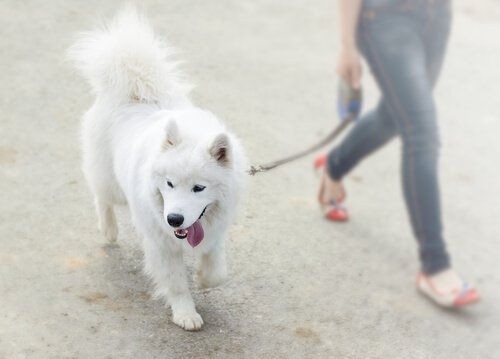Walks With Your Dog: 10 Tips for Improving Walks


Written and verified by the lawyer Francisco María García
One of the most annoying aspects of being a dog owner is not being able to take your dog out for a nice, calm walk. It can be stressful when your dog is constantly pulling on their leash and ignoring instructions. That’s why we’ll give you 10 useful tips for improving walks with your dog.
1. The collar
Your dog’s collar is an essential element when it comes to walks and it can make all the difference while out for walks with your dog.
However, we don’t recommend using some types of training collars, such as choke collars. These create extreme pressure on the dog’s neck when they pull on the leash. In the long run, using this type of collar can cause more problems. When a dog tugs on the leash it can injure him.

2. Harnesses
Harnesses are much less dangerous than choke collars. However, they do put some pressure on the dog’s torso but it’s much less extreme than pressure from choke collars. A good harness can help you have more control over your dog and help improve the walks you go one with them.
3. Control them during walks
Walk your dog calmly and with control. Phrases like “let’s go bye bye” or other things that get them excited is not a good way to start the walk. Your dog should see walks like a normal discipline.
4. Freedom
Your dog doesn’t like to be tied up. Your dog will certainly love a place where they can walk off the leash. You can take your dog to a dog park, an open field, or a place where your dog can run safely from hazards (cars, roads, etc.). This allows them to play freely and sniff around wherever they want (always under your observation, of course). Allowing them to play freely will be reassuring and they will remember it for future walks.
5. Rewards
Treats are key to any dog’s training because you can reinforce good behavior with them. If you scold your dog during the walk, then you will create a negative experience for your dog.
6. Identification
It is very important that your dog wears a tag with your current phone number on it. You can also use a tattoo or a chip. In case you lose control of the leash, their collar breaks, or another unforeseen circumstance occurs, you will always know that you can get your dog back home safely. If somehow your pet gets lost, these devices contain data that can help you find them.
7. Accidentally letting go of the leash
Dogs are like children in a lot of ways. If you accidentally let go of the leash, your dog will most likely take off running. The best thing to do in this case is to follow them. Don’t run after them screaming because they might think it is a game. When you follow them, make sure you do it at a calm pace. When your dog sees you, don’t run after them. Crouch down and sit on the ground. Call them calmly and offer treats — their favorite toy, etc. — in order to get them to approach you and that way you can grab them.
8. Going to the bathroom
It’s important to always clean up after your dog. It will only take just a few seconds. This helps maintain a healthy and clean living environment with your neighbors. It also helps prevent you from stepping on dog feces that you left from the day before.
9. Marking their territory

All dogs have a territorial instinct. Therefore, they want to mark their territory during the walk, and smell trees to know what kind of dogs have gone by there. Therefore, you’ll need to be patient and let them smell things and mark their territory.
10. Barking
Barking at other dogs or people during walks can get annoying. In order to avoid it, you need to distract your dog. As a dog owner, you can tell when your dog is about to start barking. At that moment, you can give your dog a little tug and make her look at you. You can show her a treat, a toy, or start her favorite game. This will distract her and avoid the very annoying barking.
Take note of these tips and see how much they can improve the walks you go on with your dog. Both you and your dog will definitely benefit from it.
One of the most annoying aspects of being a dog owner is not being able to take your dog out for a nice, calm walk. It can be stressful when your dog is constantly pulling on their leash and ignoring instructions. That’s why we’ll give you 10 useful tips for improving walks with your dog.
1. The collar
Your dog’s collar is an essential element when it comes to walks and it can make all the difference while out for walks with your dog.
However, we don’t recommend using some types of training collars, such as choke collars. These create extreme pressure on the dog’s neck when they pull on the leash. In the long run, using this type of collar can cause more problems. When a dog tugs on the leash it can injure him.

2. Harnesses
Harnesses are much less dangerous than choke collars. However, they do put some pressure on the dog’s torso but it’s much less extreme than pressure from choke collars. A good harness can help you have more control over your dog and help improve the walks you go one with them.
3. Control them during walks
Walk your dog calmly and with control. Phrases like “let’s go bye bye” or other things that get them excited is not a good way to start the walk. Your dog should see walks like a normal discipline.
4. Freedom
Your dog doesn’t like to be tied up. Your dog will certainly love a place where they can walk off the leash. You can take your dog to a dog park, an open field, or a place where your dog can run safely from hazards (cars, roads, etc.). This allows them to play freely and sniff around wherever they want (always under your observation, of course). Allowing them to play freely will be reassuring and they will remember it for future walks.
5. Rewards
Treats are key to any dog’s training because you can reinforce good behavior with them. If you scold your dog during the walk, then you will create a negative experience for your dog.
6. Identification
It is very important that your dog wears a tag with your current phone number on it. You can also use a tattoo or a chip. In case you lose control of the leash, their collar breaks, or another unforeseen circumstance occurs, you will always know that you can get your dog back home safely. If somehow your pet gets lost, these devices contain data that can help you find them.
7. Accidentally letting go of the leash
Dogs are like children in a lot of ways. If you accidentally let go of the leash, your dog will most likely take off running. The best thing to do in this case is to follow them. Don’t run after them screaming because they might think it is a game. When you follow them, make sure you do it at a calm pace. When your dog sees you, don’t run after them. Crouch down and sit on the ground. Call them calmly and offer treats — their favorite toy, etc. — in order to get them to approach you and that way you can grab them.
8. Going to the bathroom
It’s important to always clean up after your dog. It will only take just a few seconds. This helps maintain a healthy and clean living environment with your neighbors. It also helps prevent you from stepping on dog feces that you left from the day before.
9. Marking their territory

All dogs have a territorial instinct. Therefore, they want to mark their territory during the walk, and smell trees to know what kind of dogs have gone by there. Therefore, you’ll need to be patient and let them smell things and mark their territory.
10. Barking
Barking at other dogs or people during walks can get annoying. In order to avoid it, you need to distract your dog. As a dog owner, you can tell when your dog is about to start barking. At that moment, you can give your dog a little tug and make her look at you. You can show her a treat, a toy, or start her favorite game. This will distract her and avoid the very annoying barking.
Take note of these tips and see how much they can improve the walks you go on with your dog. Both you and your dog will definitely benefit from it.
This text is provided for informational purposes only and does not replace consultation with a professional. If in doubt, consult your specialist.








